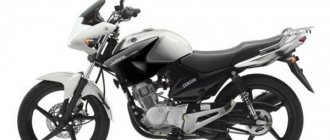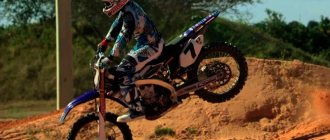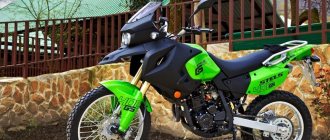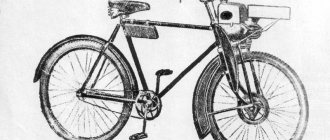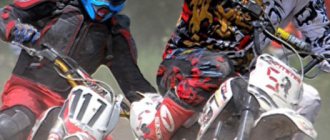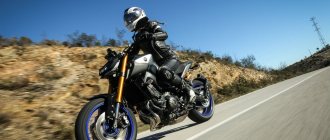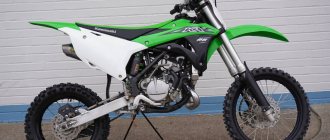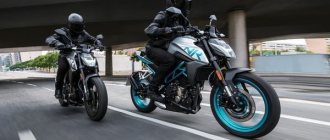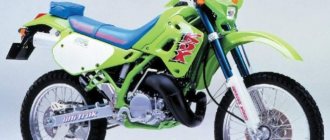“What is the difference between cross and enduro?” - a question that any motorcyclist asked himself or Google, regardless of driving experience. They are close enough to each other that one can confuse them endlessly if one has not had the joy of riding both.
As with any type of technology, differences in model series depend on the purpose and method of operation. As soon as you mix mud on an enduro or drive at the cut-off with adrenaline at 15 on a 10-point system of your capabilities, you will immediately begin to see a clear difference without any theory.
If we talk about these classes in general, then their differences are:
- Power apparatus
- Power system
- Electrical system
- Suspension/wheels
- Tuning/additional elements
Power apparatus
Motocross motorcycles are designed to take off on a track that is oh so far from road racing. The only goal of the engine is to work at its maximum so that the pilot reaches the finish line first and, ideally, on horseback, intact, unworn. Crosses do not need cruising speed. Give them a fighter flight! Therefore, such engines have enough gunpowder to operate in the cutoff, but do not feel well at the bottom, which for them is like the slowmo effect for a person who has drunk three liters of energy drink.
For enduro motorcycles with bottoms, everything is simpler. Such engines are designed for routes with which the pilot is not familiar, for driving with possible hitches due to road conditions. Therefore, where an enduro can quietly crawl sideways at medium speeds, a cross bike can simply overheat when stuck in the mud.
A few words about the checkpoint. Since the cross is all about speed, the gears are short, very short, so close that sometimes, out of habit, you don’t understand whether you’ve shifted or not.
In enduro, the shifting is more noticeable, the gears are a little longer, again due to the low end.
A long time ago, one very famous guy spent a lot of time in the Galapagos, examining insects, turtles and other organisms, with only one goal - to prove the theory of evolution and explain to non-believers that all crawling things will sooner or later become flying... So I once (also a long time ago) a long time ago, but not that long) switched from a car to a motorcycle.
I drove... I flew... and all that... And then I decided to exchange my life-worn Pepelats for a less shabby one. I sold it quickly, but for some reason the purchase didn’t work out... The vast majority of the equipment turned out to be in worse condition than what I had, and at the same time the prices... Mom, don’t worry.
A couple of times I even drove to neighboring cities in a car with a trailer. Only to admire the wisdom of the next seller and go back light))) But he who seeks will find. And a suitable option was also found. Nearby. In the suburbs. Every motorcycle traveler knows that the Samara region is practically a suburb of Tyumen.
I talked to the seller and checked out his brilliant video on measuring compression and the appearance of the motorcycle. Then he bought tickets for the nearest train and hit the road, simultaneously admiring the multinationality of Russia, its vast expanses, landscapes and other pictures floating outside the window of the reserved seat carriage.
By the way, traveling by train to Makhachkala is highly recommended for thrill-seekers. And for special connoisseurs of the romance of Russian Railways, I advise you to buy a ticket at the ticket office for seat No. 37 (lower side near the toilet). As if by the way, I appreciated the luxury of the stations and the gorgeous tan of the fit Papuans, moving in the opposite direction and showing off the charms of their bodies on each platform.
In Samara I was met by the former owner of my future motorcycle. They quickly changed the chain, oil, put on a windshield... And loaded the equipment with bags and string bags, as a tribute to the memory of the USSR, since the year of production of the Pepelats was 1993 (although he did not see the Union, he fully appreciated the time of change).
Next, we quickly register... And we fly home, without lowering the visor (helmet visor) and studying the taste of insects living in the middle zone. Traffic jams on the M5 highway and in cities along the way are simply terrible. I was glad a thousand times that I was traveling by motorcycle and not by car. Initially I planned to fly in a day... But I left Samara in the afternoon, and the tire broke about 50 km after Ufa. Therefore, I spent the night on the highway and repaired it in the morning.
Well, on the road again. Despite the fact that the main purpose of the event was transportation, not tourism, I couldn’t deny myself the pleasure of climbing Karabash along the way. There people can barely climb on foot, so they look at you like you’re crazy... No, but where have you seen an adequate motorcyclist? And even for enduro?
Upon arrival, the motorbike was disassembled, carefully inspected again and some things were even repaired... But that's a completely different story...
I'm not much of a writer, it's easier to watch a movie. Well, I think so.
Electrical system
The first thing that allows you to identify an enduro is the headlights and brake light. Cross doesn't need all these bells and whistles. Enduro has a whole list of dual-purpose models that no one would have released on civilian roads without additional lighting devices. Moreover, endurist routes take place not only during the day, but night races also exist, so let there be light!
Kickstarter and electric starter. On motocross motorcycles, the engine starts only before the race; the kickstarter system, as simple as boots, is light and reliable, which is why you will see a kickstarter on many models.
What is enduro? The history of the popular motorcycle movement in detail
Many people have heard the word “enduro” - this is the name for both off-road motorcycles and cross-country racing. But few people know what exactly this word means. It's actually the name of one of the most famous off-road motorcycle races. It has been held for more than a hundred years, and modern enduro motorcycles have largely become what we are used to thanks to this race...
At the dawn of the twentieth century, England and France were the leaders in motorcycle manufacturing. They gave impetus to a new sport - endurance competitions, in French - endurance.
Since 1907, the Tourist Trophy competition began to be held on the Isle of Man, and in 1908 the prototype of motocross, the Fox Chase, appeared. The International Motorcycle Federation FICM (later FIM) decided to combine both directions. The first enduro race in 1913, in the English town of Carlisle, featured several British and three French riders, and the competition took place over six days. The official name of the International Six Day Trial did not contain the word “enduro” - it appeared only in 1981, when the competition was renamed (ISDE).
From the first races until 1957, motorcycles with sidecars were allowed
From the very beginning, the competition has been held annually, with only interruptions during the First and Second World Wars. What distinguishes ISDE from other types of motorsports is primarily its team spirit. The main prize, the Nations Cup (later the World Trophy), is awarded to a national team of a certain composition. In addition to the team Trophy, others were awarded over the years. In 1923, the Silver Vase Trophy was established, but in 1985 it was abolished and the Junior Trophy was introduced for riders under 23 years of age. In 2007, the “Women’s Class” – Women’s Cup – was established. The “Factory Brand Trophy” was also raffled off among motorcycle manufacturers. Until 1970, riders could only compete in the Nations Cup on motorcycles manufactured in their own country.
The essence of the competition is to regularly move along a long route (more than 1200 km long) for six days and to win in additional speed disciplines. Additional competitions include cross-country starts, climbs, and acceleration tests. The final used to be a general road-circuit race, then it was replaced by a cross-country race.
In the early post-war years, British heavy motorcycles were still winning (pictured is a 1948 Royal Enfield)
The rules of the “six-day” are quite complex, the requirements for technology, the type and nature of the disciplines, as well as the procedure for penalties have changed several times. For this, the competition received the description of the most intellectual type of motorsport, a kind of motorcycle Olympics. It’s difficult not only for racers, but also for coaches and mechanics. In general, like chess: a game full of surprises, with many options.
POLYGON
ISDE competitions, like no other, have become a testing ground for many technical solutions. By assessing the technology launched in different years, you can trace the path of progress, see its dead-end branches, changing trends and leaders.
At the beginning of the history of the “six days”, heavy but high-quality British and French equipment dominated. Motorcycles produced in Germany, Italy, Belgium, and Sweden successfully competed with it - these countries were great motorcycle powers before the Second World War. Motorcycles were distinguished from road bikes mainly by starting plates and tubes and pumps attached to free places (the latter later replaced compressed air cans). Here are the brands that were popular in pre-war competitions: AJS, Ariel, BMW, Brough-Superior, BSA, DKW, FN, Gilera, Gnome-Rhône, Harley-Davidson, Indian, MAC, Matchless, Peugeot, Royal Enfield, Rudge, Sunbeam, Terrot, Triumph, Velosette, Zündapp. Today, most of these names are known only to motorcycle antique dealers. Motorcycles were mainly equipped with a lower valve four-stroke “single-barrel” engine, a parallelogram fork and a rigid rear suspension.
The fifties were marked by the rapid advance of “two-stroke” engines (pictured is a well-equipped Austrian Puch)
Since 1947, the Motorcycle Olympics resumed, and technology began to change very quickly. Two-stroke engines appeared on the scene, suspensions, which had not changed for almost half a century, were improved. Riders appreciated the frames with a rear swing fork and the use of “hydraulics”. New names appeared in motorsport, old companies got a second wind. The riders achieved victories on Bultaco, Laverda, Maico, and Husqvarna motorcycles. Jawa and ČZ from Czechoslovakia, Simson and MZ from the GDR played a prominent role in the 60s and 70s. And in the USSR they developed their own motorcycles, and since 1956, Soviet athletes have repeatedly participated in the FIM “six-day race” (read more about this in the next issue of the magazine). Motorcycles from Germany - Zündapp, BMW and NSU - did not lag behind. English brands have fallen into disrepair, just like classic four-stroke engines. Since 1957, the FIM has abolished the participation of motorcycles with sidecars in competitions. But small-capacity motorcycles, even 50-cc ones, were given the green light and placed in a separate class. In addition to it there were classes “75”, “100” and “125” cubic meters. see. Here the names Hercules, Puch, Sachs, Simson, Zündapp sounded triumphantly.
The seventies were marked by the almost complete victory of two-stroke engines. So, in 1974, out of 296 motorcycles in eight classes, there were only four with 4T engines. The riders from Great Britain remained faithful to them until the last, but next year they too switched to Javas with two-stroke engines. And the era of Austrian KTM motorcycles began, the success of which was greatly facilitated by the victories in world motocross of our fellow countryman Gennady Moiseev.
One of the technical wonders of the 20th century, the Wankel rotary engine was also tested in ISDE racing (pictured Hercules Wankel 1975)
The sixties and seventies were years of searching, sometimes curious and dead-end. In 1960–1961, motor scooters were included in the Polish and English teams. WFM OSA and Lambretta-175 drove well on the roads, but they were dragged through mud and fords. American Rokon Automatic motorcycles (1974) featured a continuously variable transmission and cord-operated engine start, similar to outboard engines. Disc brakes are also new. In 1975, a well-equipped Hercules Wankel motorcycle with a rotary piston engine appeared for the first time at the six-day competition. In 1977, the Canadian Can-Am 175 Qualifier, produced by the world snowmobile leader Bombardier, tried its hand.
In 1974–1975, the American team tested an unusual Rokon motorcycle with a continuously variable transmission
And in these same years, “Japanese” began to appear on the highways. One of the first signs was the Yamaha 500 Enduro with a new generation four-stroke engine. But these engines were not able to displace the “two-stroke” engines for a long time, because the latter quickly improved and gained more horsepower. They tested intake spools, reed valves, liquid cooling and electronic control systems. In the mid-70s, the power of the two-stroke engine of the most popular class “250” reached 40 hp. s., while the weight of the entire motorcycle was less than 100 kg. In the 80s, the power of the 2T unit in the “royal” class began to exceed 50 hp. With.
The FIM Organizing Committee often changed the rules of the “six-day race” - restrictions were introduced on various parameters, classes and requirements for team composition were changed. For example, since 1982, suspension travel was limited to 250 mm (they became smaller than before), the “80” class was introduced, abolishing “50”, “75”, “100” and “175”. Since the late 90s, when four-stroke engines regained their strength, they began to equate them with two-stroke engines of smaller cubic capacity, but approximately the same power. Today the division into classes looks like this: class E1 – 100–125 cc. cm (2T) and 175–250 cc. cm (4T), class E2 – 175–250 cc. cm (2T) and 290–450 cc. cm (4T), class E3 – 290–500 cc. cm (2T) and 475–650 cc. cm (4T).
The socialist countries, represented by Czechoslovakia and the German Democratic Republic, had very strong teams in the 60s and 70s, largely due to their equipment
Restored 1961 Jawa-250 and 1974 MZ-250
BY COUNTRY AND CONTINENT
To date, six-day competitions under the auspices of the International Motorcycle Federation have taken place 89 times. The first competition in 1913 attracted 162 riders, and recently the ISDE has attracted about 500 of the world's best athletes.
Initially, the country whose team won the International Trophy received preferential rights to organize the next six-day tournament. However, the 1969 FIM Congress revoked the winner's right, leaving the choice of venue to itself. This decision was quite sound, because since 1967, ISDE received the status of a world team championship, and the federation decided to give countries of other continents a chance to win. In 1973, the six-day race left Europe for the first time and moved to the United States. In subsequent years, the competition visited Australia (1992 and 1998), again the USA (1994), Brazil (2003), New Zealand (2006) and Chile (2007).
The Lambretta-175 motor scooters looked unusual against the backdrop of seasoned “cross bikes” - in 1960, racers from Great Britain rode them
The Great Britain team has the largest number of victories in team racing - 16. But all this is a triumph of bygone years - the last victory of the Foggy Albion riders dates back to 1953. The Czechs are second, with 15 victories, and these are also achievements from the times of Czechoslovakia. The Italian team has won the main trophy 14 times since 1930. In recent decades, luck has favored teams from France, Finland and even Poland. But the US team was unlucky - they never won. However, like our riders: the USSR national team never won the World Trophy.
In the 80s, Japanese motorcycles began to actively push out the traditional favorites (pictured is one of the first “Japanese” Suzuki PE250T in the Australian team in 1980)
CHILDREN ENDURO
Along with ISDE, the Maxxis FIM World Enduro Championship (WEC) has been held as a world championship since 1990. This race series replaced the FIM European Enduro Championship, which had existed since 1968. The series currently consists of eight two-day rounds, including motocross, enduro and extreme testing. Another world-class competition is the FIM SuperEnduro World Championship. These spectacular races take place in a stadium where a dirt or sand track is laid out with obstacles of a mostly natural nature (rocks, logs, water areas, etc.) similar to those found on a classic enduro track. Competitions related to enduro include country crosses, enduro crosses, extreme enduro, bajas and rally raids. But this is a topic for another conversation...
Enduro of the early 80s: air cooling and drum brakes have not yet sunk into oblivion
In the foreground is the Italian motorcycle SWM-250
Materials were used from the book by P. Husak “Enduro Yesterday, Today, Tomorrow”, as well as those posted on the website speedtracktales.com. Special thanks to the President of the NRMF, MSMK Grigory Shulik for consultations and materials provided
Suspension/wheels
Cross racing is characterized by jumping; the track has jumps or quite harsh terrain, which requires appropriate design. Hence the rigid forks. If you look closely, on cross-country the fork offset is greater than on enduro, because at increased speeds the offset helps against wobbling, and sharp turns and mega handling are needed at lower speeds, like in enduro, when avoiding obstacles. Due to the jumping techniques, the cross-country landing is high. On enduro, the seating position is lower and the shock absorption is softer.
Cross-country wheels have low-profile rubber, enduro also uses low-profile rubber, but has an inch of clearance on the rim so that the rider can deflate the tire pressure to continue the race with better grip.
